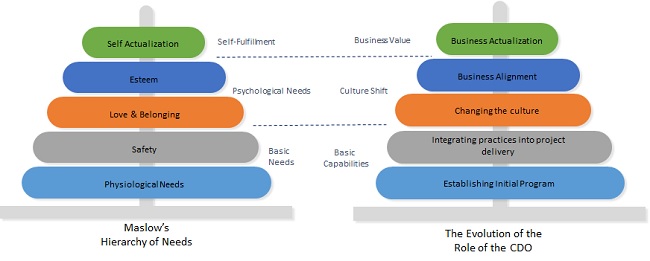
Page 2 of 2
Time to Level Up: The Evolving Role of the Chief Data Officer
Evolution of the CDO: The Early CDO
In the early 2000s, the first CDOs were appointed, particularly in the financial services industry. Those CDOs merely set up a basic data management program. They had to create new organizational policies and standards, develop a data strategy, and establish basic guiding principles for how the organization would begin treating data as a strategic asset. These CDOs developed best practices and tried to balance the culture of the organization so they could successfully implement the basic tenets of a data management program. More CDOs were appointed in the late 2000s to address added regulatory pressures brought on by the financial crisis.
In the early years, there were countless discussions across many levels of their organizations about who should be accountable for the data (and why), and why governance processes and structures were needed. At this basic level, the role of a CDO was similar to a plumber's -- to establish the basic pipes of the program, explaining why people should care, then slowly integrating new practices into daily activities so that data management would become woven into the fabric of the organization.
There were significant challenges as the CDO role was established. Many of the early CDOs would tell you that it was a tough job, often thankless, and often not successful without strong C-level sponsorship. At that time, it was difficult to find an organization that understood the value of its data and why it should be managed and protected.
During this time, many CDOs were managing the expectations of the overall data management program, perhaps even addressing regulatory issues and/or internal audit issues. They were striving for business actualization -- delivering value to the business. As a result of their numerous challenges and priorities, the tenures of the CDOs were often short, typically two to three years. Despite this short tenure, many of these CDOs were establishing the basic foundational tenants of a data management function, hiring the right talent, instituting the basic governance and data quality processes. Many of these CDOs were building the foundation for the CDOs that would follow in their footsteps.
Today's CDO
A CDO who comes into an organization today may be replacing a CDO or filling a position the organization has just created. In either case, CDOs today don't have to convince an organization to treat data as a strategic asset because there have been years of having a CDO in the role or because the data management industry (and/or the organization) has a level of maturity about understanding that data provides a competitive advantage.
The role of the CDO is now focused on delivering the business value immediately. Those CDOs who are replacing a CDO within an organization realize the benefit of the previous CDO in establishing the basic tenants of the program so they can now deliver the business value faster. For the CDO role just created, the high expectations of achieving the immediate and direct business value may be challenging if the basic data management tenants around people, processes, and technology have not been established.
The Hierarchy of Data Needs: A Comparison
We can draw parallels to the evolving role of the CDOs to Maslow's hierarchy of needs. In psychology and the behavioral sciences, Maslow's hierarchy provides a framework to discuss how needs motivate people. The concepts are simple: at the most basic level, a person needs food, water, and shelter. At the next level, a person needs security and safety. Once those needs are met, a person needs love and relationships. Next, a person seeks a sense of accomplishment and self-esteem. At the highest level in the hierarchy is self-fulfillment -- actually achieving one's full potential (see figure).

Evolution of the Chief Data Officer
The concepts are similar for an organization's data needs. At the most basic level, organizations need their data to be available, trusted, and secured for their individual department needs. The CDO starts here to address those needs by establishing the initial program and deploying the foundational capabilities in technologies, processes, and accountability. Once the basic capabilities are set, the role of the CDO becomes more political, focusing on changing the culture of the organization. Enterprise data is vast and touches every facet of an organization, so aligning all stakeholders and getting everyone to move in the same direction is not an easy task.
As the culture of the organization begins to embrace the data management function, the CDO next focuses on driving business outcomes. The CDO at this point is tightly aligned with the business stakeholders -- he or she is a trusted partner delivering the capabilities needed to reach the ultimate goals of the business.
The testament of success to any data management program or CDO is the ability to truly fulfill the needs to the business -- that is, business actualization. This involves more than simply providing integrated, high-quality data in a timely manner. It requires delivering the capabilities that directly impact strategic decisions, which have a huge impact on the business. Examples include the ability to predict the next outbreak of a disease, developing a new product or sales channel, targeting a brand new customer base, predicting customer behaviors, generating new streams of revenue, and advancing business capabilities that directly positively impacts revenue growth.
Maslow believed that an individual does not move up the hierarchy in a straight line. Life circumstances, such as accidents, deaths, and divorce, may force an individual to move back in the hierarchy, so there is a constant movement up and down the hierarchy -- all with the goal of achieving self-fulfillment. Each individual does not move at the same pace and in the same way through the hierarchy.
Similarly, an organization does not advance its data management capabilities in a straight line. Various challenges, including silos, lack of consistent executive sponsorship, "data hoarding," and employees who are resistant to change, will impact the progress. In addition, just as Maslow said that each individual will move at a different pace, so will each organization. The timeline to reach business actualization depends on many factors, and the role of the CDO is to continually drive toward that goal.
Maria Villar and Theresa Kushner have written further about using Maslow's hierarchy of needs as a framework for your data strategy.
The Tenure of a CDO
Early CDOs faced an uphill battle, often meeting resistance to changing behavior and practices from all levels in their organizations. Many CDOs at that time left their roles within a short period. Even today, very few CDOs make it past the two- or three-year mark. According to Gartner's second annual CDO survey in 2016, only 14 percent of CDOs have been in the role 4-6 years, and 3 percent have been in the role seven years or longer. According to this survey, the average CDO has been in the role for just 2.4 years.
Enterprise data management is challenging; every person within a company creates, touches, manipulates, or analyzes data. For a single person or a small organization, managing all of a company's data is a daunting task, especially when the company culture is resistant to change. We often compare it to rolling a huge boulder up a very steep hill. One day you might have a small success and the rock moves a bit forward, the next day you have a setback and the boulder rolls back a bit, and on another day, the boulder flattens you!
Being a CDO is not about best practices, technology, or value -- it is about people. The number one challenge that every CDO faces is managing the culture within an organization. Changing people and culture is a process -- it does not happen overnight. For organizations that are apprehensive about change and lack consistent senior-level sponsorship, the attention span for supporting a CDO is about two to three years. Once that span has been reached, the next CDO is hired to continue to move the rock up the hill and so on. Changing the culture also requires "new blood" from time to time to change the landscape, to add a new voice, or to find a new approach to an old problem. However, with each CDO, progress is made and the rock moves a little further up the hill. For people who are passionate about data, it is all worth it!
Summary
Just as the data landscape has changed over the years, so has the role of the CDO. As the role has evolved and more organizations have established their basic capabilities, the role of the CDO is more commonly focused on business outcomes. A strong CDO drives the practices and solutions that deliver direct, meaningful impact to the organization, and an organization may work with several CDOs in succession before reaching business actualization.
If you are replacing a CDO who has laid the groundwork (at the bottom of the hierarchy), you are well on your way to moving up the hierarchy. Achieving business value actualization will be faster -- and we predict the CDO tenure will get longer over-time.
If you're a CDO in a newly created position, you may find challenges because you'll have to meet the expectations of business actualization despite the lack of the basic tenants of a data practice and overall organizational data management immaturity. Unfortunately, the necessary "needs" groundwork has not been done in infrastructure, governance, data quality, business accountability. You may be at risk for a shorter tenure. You will need to quickly establish short-term wins, set clear expectations, and establish consistent key executive sponsorship.
About the Authors
Beth Hiatt has over 25 years of experience in data management. She was the first chief data officer for Fannie Mae, where she was responsible for the creation and deployment of the enterprise data management function. She has worked in various capacities throughout her career within both business and technology roles. She is currently the chief information officer for a data management and analytics consulting company, Unissant, where she is responsible for defining and deploying data management solutions across clients in both the commercial and federal sectors. You can contact the author at [email protected].
As Head of Enterprise Data Strategy & Transformation, Maria C. Villar advises SAP customer's on the crucial role of data management in their digital transformation, leveraging over 20 years of practical, operational experience as the Chief Data Officer of 3 companies, including SAP from 2009-2017.
In 2017, Maria was honored with the "Transformation of Collaboration From Inwards to Outwards" Award from the Massachusetts Institute of Technology. This award from MIT recognizes outstanding CDO leadership in driving business outcomes and business collaboration.
In addition to her SAP experience, she has authored a book "Managing your Business Data from Chaos to Confidence".
Also, published 2 online classes and numerous articles, most recently "Time to Level Up: The Evolving role of the Chief Data Officer".
As a SAP trusted advisor to our most senior customers, the customer engagement approach is typically at the CXX level i.e. CDO, CIO, COO, CFO.